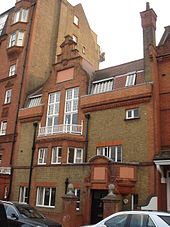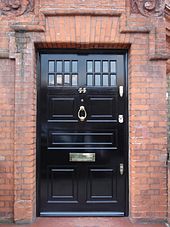Tite Street

Tite Street is a street in Chelsea, London, England, within the Royal Borough of Kensington and Chelsea, just north of the River Thames. It was laid out from 1877 by the Metropolitan Board of Works, giving access to the Chelsea Embankment.[1]
History
The street is named after William Tite who was a member of the Metropolitan Board of Works, responsible for the construction of Chelsea Embankment to the south of Tite Street.[2]
Gough House stood on the eastern side of the street, and was built around 1707. It became a school in 1830, then the Victoria Hospital for Children in 1866. In 1898, the building was considered inadequate for its purpose.[3] The hospital moved to St George's Hospital, and the original building was demolished in 1968. The site is now occupied by St Wilfred's convent and home for the elderly.
In the late 19th century, the street was a favoured and fashionable location for people of an artistic and literary disposition.[2]
On 27 November 1974, two bombs planted by the Irish Republican Army (IRA) on Tite Street injured 20 people, as part of a wider set of bombings.[4]
A private entrance to Gordon House is located between 35 and 37 Tite Street.[5]
River House in Tite Street was designed by the church architect Thomas Garner. It has been Grade II listed since 1962.[6]
Notable occupants
The following people have lived in Tite Street:
- No.3:
- Gustav Pope, Victorian painter (1831-1910)
- No.5:
- Frederick Chesson, anti-slavery campaigner
No 16:
- Julian Mond, 3rd Baron Melchett (1925-1973) Chairman British Steel Corporation
- Sonia Melchett, Baroness Melchett (1928-) socialite and author
- Peter Robert Henry (1948-) 4th Baron Melchett former Lord in Waiting, Parliamentary Under-Secretary of State and Minister of State
- Andrew Sinclair (1935-) novelist, historian, biographer, critic and filmmaker.
- No.18:
- Paul Edward Dehn, writer
- No 30 (formerly 12A):
- Peter Warlock, composer — marked with a blue plaque. Warlock died here on 17 December 1930, probably suicide.
- No 31 (residence) & 33 (formerly 13)(studio):
- John Singer Sargent, American portrait painter.[7]
- No 33:
- James McNeill Whistler, artist.[8]
- Augustus John, artist[8] — intermittently between 1940 and 1958.
- Glyn Philpot, artist
- Robert Brough, Scottish artist
- No 34 (formerly 16[9]):
- Oscar Wilde lived here from his marriage in 1884 until his arrest in 1895.[2] This location is now marked a blue plaque.[10]
- No 35:
- Whistler instructed Edward William Godwin to build the White House here, but due to his bankruptcy after his legal case with John Ruskin, he was never able to occupy it; the building was demolished in the 1960s.[2]
- Chelsea Lodge, No.42: (demolished)
- Edwin Austin Abbey, artist


- No 44 (formerly 1):
- Frank Miles, portrait painter (also commissioned from Godwin).
- Oscar Wilde, writer[11] who moved into this house, built for Miles, as Miles's lodger before later renting No 34 himself.
- George Percy Jacomb-Hood, artist, brother-in-law of Miles's cousin Philip Napier Miles, lived at Miles's house from 1897 until his death in 1929, his father having bought it from Miles's executors.
- No.50:
- Romaine Brooks, artist
- Anna Lea Merritt, American artist
- No.52:
- John Collier, artist
- Wendela Boreel, artist
- Shelley Court, No.56. Flat No.15:
- Sir Wilfred Thesiger, explorer and travel writer.[12]
- Shelley Court, No.56. Flat No.17:
- Radclyffe Hall, feminist writer
- No (not known):
- Squadron Leader Roger Bushell RAF (30 August 1910 – 29 March 1944). South African-born British Auxiliary Air Force pilot, who organised and led the famous escape from the Nazi prisoner of war camp, Stalag Luft III.[13]
Further reading
Cox, Devon (2015), The Street of Wonderful Possibilities: Whistler, Wilde and Sargent in Tite Street, London: Frances Lincoln, ISBN 9780711236738
References
Citations
- ^ Patricia E.C. Croot (editor) (2004). "Settlement and building: From 1865 to 1900". A History of the County of Middlesex: Volume 12: Chelsea. Institute of Historical Research. Retrieved 27 January 2013.
{{cite web}}:|author=has generic name (help) - ^ a b c d Weinreb et al. 2008, p. 918.
- ^ Walter H Godfrey, 'Paradise Row, south side: Gough House', in Survey of London: Volume 2, Chelsea, Pt I (London, 1909), pp. 8-9. British History Online http://www.british-history.ac.uk/survey-london/vol2/pt1/pp8-9 [accessed 26 October 2019]
- ^ https://cain.ulster.ac.uk/othelem/chron/ch74.htm
- ^ Christopher Middleton (23 April 2012). "The Royal Hospital Chelsea up for sale". The Daily Telegraph. London.
- ^ Historic England (26 September 1962). "The River House (1358136)". National Heritage List for England. Retrieved 26 October 2019.
- ^ Sargent's Tite Street Studio Archived 23 May 2007 at the Wayback Machine, JSS Virtual Gallery.
- ^ a b Chelsea Walk — Tite Street, Virtual Museum, Royal Borough of Kensington and Chelsea.
- ^ "Registrar General Records". Wilde, Oscar O'Flahertie Wills (1856–1900), author. National Archives. Retrieved 12 March 2010.
- ^ "Oscar Wilde, Poet". English Heritage. Retrieved 26 October 2019.
- ^ Authors —> Aesthetes and Decadents —> Oscar Wilde —> Biographical Materials, The Victorian Web, Archive.org.
- ^ Hanbury-Tenison, Robin. "Obituary: Sir Wilfred Thesiger 1910–2003 by Robin Hanbury-Tenison". travelintelligence.com. Archived from the original on 15 April 2012. Retrieved 29 December 2011.
- ^ 7 BBC Storyville documentary The Real Great Escape Dir.Lindy Wilson (http://www.bbc.co.uk/programmes/b01ghtll) Broadcast 19 April 2012
Sources
- Weinreb, Ben; Hibbert, Christopher; Keay, John; Keay, Julia (2008). The London Encyclopaedia (3rd ed.). Pan Macmillan. ISBN 978-1-405-04924-5.
